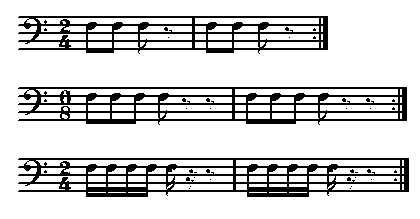Using your tongue – including double tonguing
- Tonguing
Start with the upper tip of your tongue just touching the reed and blocking the aperture. The air is restrained by your tongue until you release the pressure by removing your tongue. If you move your tongue back in the mouth like saying the letter T you get a hard attack, and if you move it downwards like a D the attack is soft. There are, of course, a range of possibilities in between. The sudden passage of air at the start of a note makes the pitch sharper so your embouchure should be more relaxed than later on when the note has begun. Notes are usually stopped by stopping the air but an abrupt end to the note can be obtained by putting the tongue back on the reed. Before the air stops, the air slows and the pitch drops unless your embouchure tightens to maintain the tuning. - Length of notes
Staccato half length Dot + line three quarter length Line full length (some composers use lines for a stress too – eg Rachmaninov & Debussy) - Accents
sf and < usually have a sharp attack. fp is usually a longer attack than <. Follow the accent with the same dynamic that you were using before, unless otherwise marked.
Some conductors like “pear shaped” accents, ie a soft attack with a long emphasis. - Double Tonguing
When you are single tonguing, for every note you play your tongue has to move backwards and then forwards in your mouth. With double tonguing you get another note with the forward stroke of your tongue. Think what your tongue has to do when you say the word “tuck”. You start with your tongue at the front of your mouth and finish with it at the back. Now when you say “cut” it does the opposite. Say ” -tuckutuckut” and you are double tonguing! The big problem is to get the K part as good as the T part. Since your tongue is in contact with the reed with a T, it speaks easily. You use T ‘s all the time so you get lots of practice. Both of these points need to be addressed. Practice getting a hard start to the K. This means relaxing your embouchure, at the start of the note, even more than with the T. Start by practising slowly and then increase the speed. Be sure that you can play your double tonguing at all speeds and not just fast ones.Here are some suggestions for exercises:

I get my students to practice them: - starting slowly and then faster,
- start with a T or a K equally frequently,
- play the rests rhythmically as well as the notes,
- choose a note initially in the easier register (between open F and the C below) and expand your range outward.
- Triple tonguing
This is for notes grouped in 3’s. Many woodwind players use TKT TKT etc and brass players TTK TTK etc. I prefer to alternate T ‘s and K ‘s ie TKT KTK etc. To do this you need to emphasise the K ‘s that are on the beat more than the other K ‘s. This is very good practice for your double tonguing! The other advantage is that you can tongue quicker (and possibly more evenly) since you are not putting 2 T ‘s together.
Your double tonguing isn’t just for continuous fast notes but is also useful in other contexts such as fast dotted rhythms. If you wait until you get a fast passage before you try out your double tonguing then you won’t be very familiar with it. When you are playing in an orchestra you will no doubt have some passages to play which are less important than others. Try out your K ‘s on some slow notes in these lesser moments and try to make them sound like your T ‘s.
